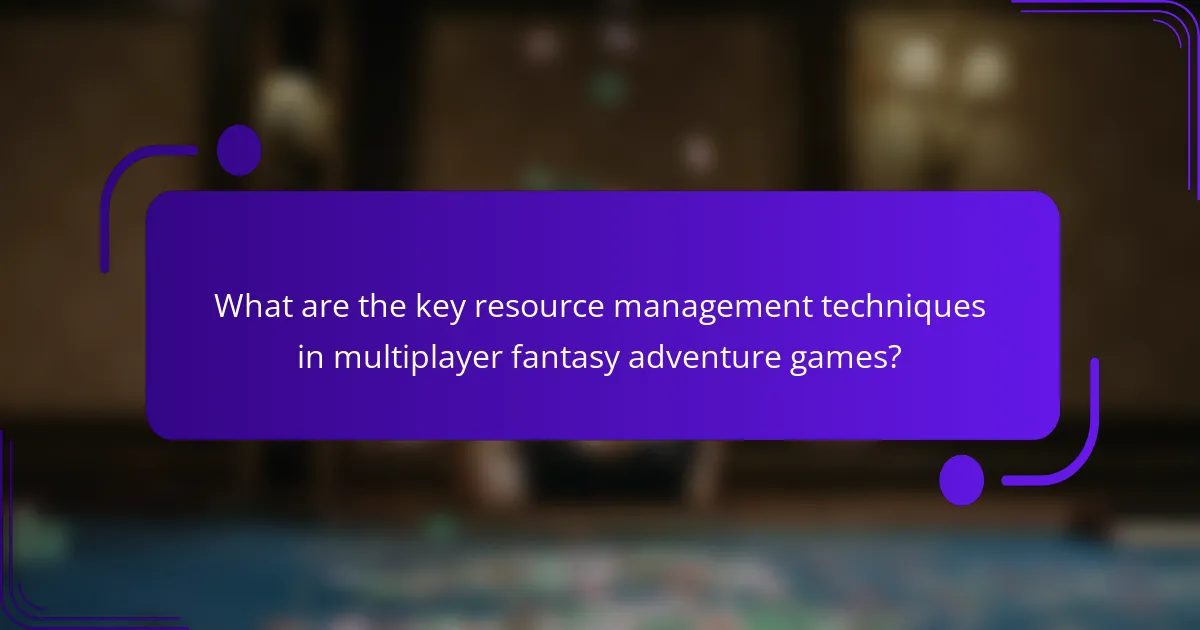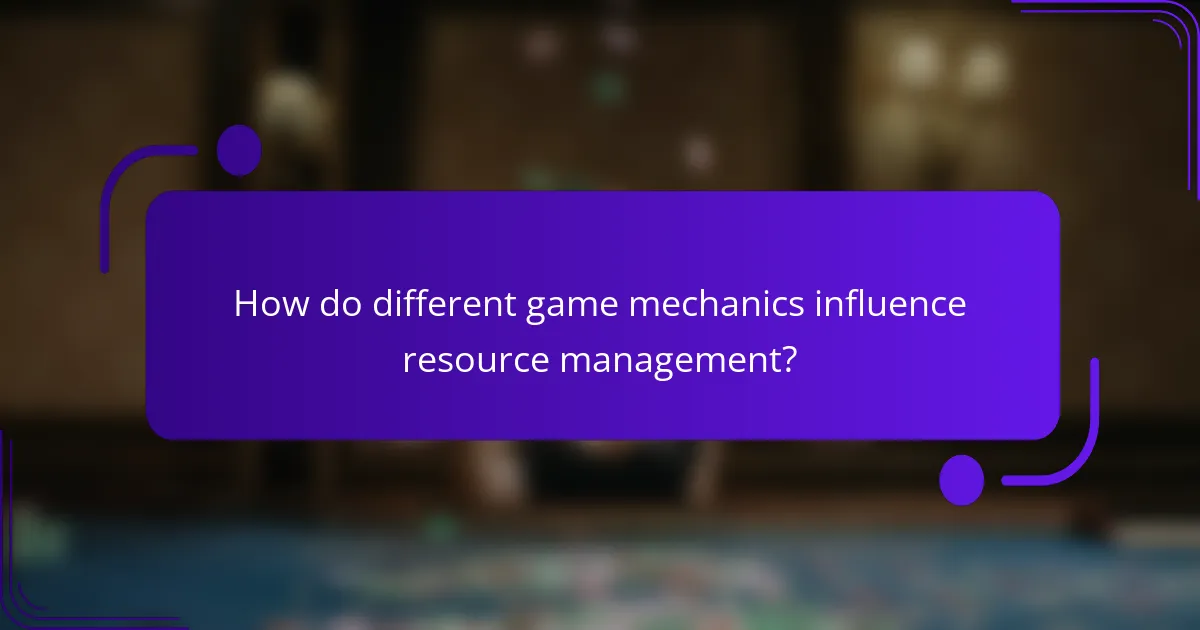Effective resource management techniques are essential for success in multiplayer fantasy adventure games. This article explores key strategies like resource allocation, collaborative gathering, and inventory management. It also examines the impact of game mechanics on player strategies and the challenges posed by resource scarcity and competition. Finally, it highlights specific examples from popular games to illustrate these techniques in action.

What are the key resource management techniques in multiplayer fantasy adventure games?
Effective resource management techniques in multiplayer fantasy adventure games include strategic allocation, collaboration, and inventory optimization. Players must prioritize resource gathering, share resources with teammates, and manage their inventory efficiently to maximize gameplay success.
Key techniques are:
1. Resource Allocation: Assigning resources based on team needs and player roles.
2. Collaborative Gathering: Working with teammates to collect resources faster.
3. Inventory Management: Keeping track of items and ensuring optimal usage.
4. Trade Systems: Utilizing in-game trading to balance resource distribution.
5. Crafting Strategies: Creating items from gathered resources to enhance gameplay.
These techniques enhance team dynamics and improve overall performance in the game.
How do players prioritize resource allocation during gameplay?
Players prioritize resource allocation by assessing immediate needs, long-term strategy, and team dynamics. They often focus on essential resources like health, mana, and equipment upgrades first. Then, players may allocate resources to enhance team capabilities or secure strategic advantages. Effective resource management leads to improved gameplay outcomes and team success.
Which resources are most commonly managed in these games?
Resource management in multiplayer fantasy adventure games typically involves managing resources like gold, food, materials, and experience points. These resources are crucial for character development and progression.
| Resource | Description | Importance |
|——————|———————————————–|——————————|
| Gold | Currency used for transactions and upgrades | Essential for acquiring items|
| Food | Sustenance for characters | Vital for health and stamina |
| Materials | Crafting components for equipment | Necessary for item creation |
| Experience Points| Measure of character growth and skill levels | Key for leveling up |
| Magic Points | Energy for casting spells | Critical for using abilities |
What strategies enhance resource efficiency for players?
Implementing effective resource management techniques enhances efficiency in multiplayer fantasy adventure games. Players can employ strategies such as prioritizing resource gathering, optimizing inventory management, and utilizing crafting systems.
1. Prioritize resource gathering: Focus on collecting essential materials early to build a strong foundation.
2. Optimize inventory management: Regularly assess and organize inventory to eliminate clutter and maximize space.
3. Utilize crafting systems: Create items that improve gameplay and provide strategic advantages.
4. Collaborate with teammates: Share resources and skills to enhance overall team efficiency.
These strategies collectively improve resource utilization, leading to better gameplay experiences.

How do different game mechanics influence resource management?
Different game mechanics significantly impact resource management by altering player strategies and decision-making processes. Mechanics such as crafting systems, resource scarcity, and trade dynamics shape how players allocate and utilize their resources. Crafting systems encourage players to gather various materials, enhancing their engagement and investment in resource management. Resource scarcity creates urgency, prompting players to prioritize their needs and make strategic choices. Trade dynamics foster collaboration and competition, influencing how resources are shared or hoarded among players. These mechanics collectively enhance the depth and complexity of resource management in multiplayer fantasy adventure games.
What role does crafting play in resource management?
Crafting plays a crucial role in resource management by enabling players to create items that enhance gameplay. It allows for the efficient use of collected resources, turning raw materials into valuable tools or equipment. This process encourages strategic planning and prioritization of resource allocation, ensuring players can optimize their inventory for challenges. Additionally, crafting can lead to unique item creation, providing advantages in combat or exploration, which reinforces its significance in resource management strategies.
How does character development affect resource utilization?
Character development significantly enhances resource utilization in multiplayer fantasy adventure games. As players invest in their characters, they unlock unique abilities that optimize resource management. This investment leads to improved efficiency in gathering, using, and conserving resources.
For example, a character specializing in herbalism can gather healing herbs more effectively, reducing the need for purchased potions. Additionally, characters with high charisma may negotiate better trade deals, maximizing resource value.
As a result, effective character development fosters strategic gameplay, encouraging players to adapt their resource management techniques based on their character’s strengths and weaknesses. This dynamic interaction ultimately enhances the overall gaming experience.

What are the challenges players face in resource management?
Players face significant challenges in resource management, including scarcity, competition, and strategic allocation. Scarcity of resources can limit player options, forcing difficult choices. Competition from other players adds pressure, as they may vie for the same resources. Additionally, players must strategically allocate resources to balance immediate needs with long-term goals. Effective resource management is crucial for success in multiplayer fantasy adventure games.
How do resource scarcity and abundance impact gameplay strategies?
Resource scarcity encourages strategic planning, while abundance allows for risk-taking in gameplay. Players adapt their resource management techniques based on availability. Scarcity often leads to prioritizing essential upgrades and conserving assets, while abundance enables experimentation with diverse strategies. Additionally, players may form alliances to share resources during scarcity, enhancing cooperative gameplay dynamics. In contrast, with abundant resources, competition may intensify as players seek to dominate through aggressive tactics. Understanding these dynamics is crucial for effective gameplay in multiplayer fantasy adventure games.
What common mistakes do players make in managing resources?
Players often make mistakes in resource management by overcommitting to one type of resource, neglecting diversification. Common errors include failing to prioritize essential resources, miscalculating resource requirements for quests, and hoarding items instead of utilizing them strategically. Additionally, players may overlook the importance of trading or collaborating with others to optimize resource use. These missteps can hinder progress and limit the effectiveness of strategies in multiplayer fantasy adventure games.

How do multiplayer dynamics affect resource management techniques?
Multiplayer dynamics significantly enhance resource management techniques by promoting collaboration and competition among players. Cooperative gameplay encourages sharing resources, leading to strategic planning and efficient use. Conversely, competitive elements may drive players to hoard resources, impacting overall game balance. Effective resource management often requires adapting strategies based on player interactions, fostering a dynamic gaming environment.
What collaborative strategies can enhance resource sharing among players?
Collaborative strategies that enhance resource sharing among players include establishing communication channels, creating resource pools, implementing trade systems, and organizing cooperative quests. These strategies foster teamwork and optimize resource utilization.
Effective communication channels, such as in-game chat or forums, allow players to coordinate and share resources easily. Resource pools encourage players to contribute items collectively, ensuring everyone benefits. Trade systems facilitate direct exchanges, enhancing player relationships. Cooperative quests require teamwork, promoting resource sharing for mutual success.
How do competitive elements influence resource management decisions?
Competitive elements significantly influence resource management decisions in multiplayer fantasy adventure games by dictating strategies and allocation priorities. Players must assess resource availability against opponents’ actions and strengths. Effective resource management involves balancing offensive and defensive tactics, ensuring optimal use of resources to gain advantages. For instance, prioritizing rare resources can provide unique benefits, enhancing gameplay and strategy. Additionally, adapting to competitors’ resource management styles can lead to innovative approaches, ultimately shaping the overall game dynamics.

What unique resource management techniques are found in specific games?
Multiplayer fantasy adventure games often utilize unique resource management techniques to enhance gameplay. These techniques include dynamic resource allocation, where players adjust their strategies based on real-time needs, and cooperative resource sharing, which fosters teamwork.
In games like “Final Fantasy XIV,” players manage resources through crafting systems that require collaboration to gather rare materials. “World of Warcraft” features a unique auction house system, allowing players to trade resources efficiently.
Another example is “ARK: Survival Evolved,” where players must balance food, water, and shelter resources to survive in a harsh environment. These techniques create engaging gameplay experiences by challenging players to think strategically about resource utilization.
How does resource management differ between popular titles?
Resource management in multiplayer fantasy adventure games varies significantly across popular titles. Each game employs unique techniques to optimize resource allocation, impacting player strategies.
For example, “World of Warcraft” emphasizes gathering and crafting, requiring players to manage materials and time effectively. In contrast, “Final Fantasy XIV” focuses on a job system where resource management revolves around skill cooldowns and party synergy. Titles like “The Elder Scrolls Online” utilize a hybrid approach, combining crafting with quest rewards to enhance resource diversity.
These differences affect gameplay dynamics, influencing player engagement and strategy formulation. Understanding these techniques can enhance a player’s experience and effectiveness in each title.
Which rare attributes shape resource management in niche games?
Rare attributes in resource management for niche multiplayer fantasy adventure games include limited resource types, unique crafting mechanics, and environmental interactions. These attributes shape gameplay by influencing strategies players use to optimize resource allocation. Limited resource types may create scarcity, driving competition among players. Unique crafting mechanics allow for specialized item creation, enhancing player engagement. Environmental interactions can introduce dynamic challenges, requiring players to adapt their resource management strategies.

How can players optimize their resource management strategies?
Players can optimize their resource management strategies by prioritizing resource allocation and planning ahead. Focus on gathering essential items early, maintaining a balanced inventory, and avoiding unnecessary expenditures.
1. Assess resource needs based on gameplay objectives.
2. Regularly evaluate inventory to prevent overstocking.
3. Use resources strategically for upgrades and crafting.
4. Collaborate with teammates to share resources effectively.
5. Monitor in-game events for opportunities to maximize resource gains.
What best practices should players follow for effective resource management?
Players should prioritize resource management by planning, monitoring, and optimizing their usage. Effective techniques include establishing a budget for resources, regularly assessing inventory, and prioritizing upgrades.
1. Set clear goals for resource allocation.
2. Track resource consumption patterns.
3. Optimize resource gathering methods.
4. Collaborate with teammates to share resources.
5. Adapt strategies based on gameplay changes.
How can players learn from expert strategies in resource management?
Players can learn from expert strategies in resource management by observing gameplay, analyzing decisions, and practicing adaptive techniques. Watching live streams or recorded sessions allows players to see how experts allocate resources efficiently. Players should focus on key strategies such as prioritizing resource gathering, understanding trade-offs, and planning for future needs.
Engaging in community discussions can provide insights into unique strategies that may not be immediately apparent. Joining forums or social media groups dedicated to the game helps players exchange tips and experiences. Additionally, experimenting with different approaches in their own gameplay can lead to discovering effective resource management techniques tailored to their play style.
By combining observation, community engagement, and personal practice, players can significantly enhance their resource management skills in multiplayer fantasy adventure games.
What tools and resources are available for enhancing resource management skills?
To enhance resource management skills in multiplayer fantasy adventure games, players can utilize a variety of tools and resources. Game-specific guides, tutorials, and forums provide strategies to optimize resource allocation. Resource management software can track inventory and usage, while analytics tools assess performance metrics. Engaging with community discussions fosters knowledge sharing, enhancing overall skills. Additionally, in-game training modules can offer practical experience.